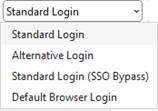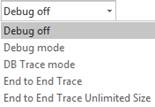Supplier Wizard - Setup Ribbon
The following table provides a quick reference to the Supplier Wizard - Setup Ribbon, and its functions.
 | ||
|
Icon
|
Description/Functionality
| |
|
Setup Visibility
 |
Once your set-up is done you may not want your users to change the setup so you can hide the setup ribbon.
There are three options:
Show at Start-up – The setup menu always appears.
Hide at Start-up – The setup menu is hidden but can be found using:
View > Macros > ShowWizardToolbars, and click ‘Run’
Hide Permanently – The setup menu is hidden and cannot be displayed. Revert back to a copy of the original workbook to display the menu.
| |
|
Login Method
 |
Choose one of the following methods for logging in:
Standard Login – This will use single sign-on where available.
Alternative Login – This will use application level sign-on.
Standard Login (SSO Bypass) - Standard Login (SSO Bypass) – This will use Single Sign-On Bypass and can be used if you have SSO installed but want to bypass the SSO mechanism. The user will be authenticated to the internal FND_USERS table rather than the external SSO.
Default Browser Login - This will use the default browser on your PC to display the EBS Login page. This is the best method to use if the ‘Standard Login’ method does not work for you.
| |
|
Debug Upload
 |
For the 5x ‘Debug Upload’ options mentioned below, the user will be under instruction from More4apps Support (used for Support purposes only). The default value is ‘Debug off’ unless instructed by More4apps to change:
Debug off – Disables any of the above options that are enabled.
Debug mode – Turns on the More4apps debug facility to generate debug messages to assist with product troubleshooting.
DB Trace mode – Generates a database trace for database Version 9i.
End to End Trace – Database trace generated for performance analysis and product troubleshooting.
End to End Trace Unlimited Size - This option allows the maximum size of trace files created whilst debugging to become unlimited. This resolves the scenario when trace files are too large that they were being truncated.
A message box will be displayed when this option is chosen allowing the user to cancel and not set the trace off:
“Please only use this under More4apps advice. A very large trace file may be created. If you are unsure, please use the ‘End to End Trace’ option rather than the ‘End to End Trace Unlimited Size’ option”.
| |
|
Operating Unit Option
 |
This option restricts the upload of suppliers based on the operating unit:
Current OU only – This option will restrict the upload to only include suppliers which have the same operating unit as the one you are logged in with.
All Available OUs – If you have a multi org responsibility this will allow you to upload all Suppliers with an organization that you have access to.
| |
|
Doublebyte Characters
 |
Optional validation check for cells which contain Double-Byte characters (relevant particularly to those using Japanese or Chinese characters i.e. Kanji or Han).
Reject – this option will restrict the upload to only allow single byte characters.
Allow – this option will allow the upload of both single and double-byte characters.
| |
|
Update APIs option
 |
Supplier Wizard uses the Oracle recommended public APIs by default when updating supplier information.
This is recommended in most cases, however, in some cases the old (unsupported) APIs need to be used to achieve updates to certain values.
The ‘Use old update APIs’ option should not be used without the guidance of More4apps or a good understanding of the public and non-public update APIs.
| |
|
Edit Template
|
This button will Show or Hide Template worksheet. If you modify the master template, subsequent worksheets created (using the ‘New Sheet’ button) will be based on this template.
This sheet stores the current logo that is used by default in the Wizard templates but can be changed at the user’s discretion.
This is common to all of our tools.
| |
|
Customize Fields
|
This button will allow you to customize the template sheet. The template sheet determines what columns will be displayed on your worksheet when a new sheet is created using the new sheet button on the Supplier Wizard ribbon.
| |
|
Include Employee Types
|
When this button is toggled on the Wizard will allow the upload and download of Employee Type and other Suppliers.
When toggled off Employee Type Suppliers are not available.
| |
|
Manage Banks/Branches
|
This icon allows the user to create a bank and branch at the same time as creating/modifying a bank account.
When icon is ON (highlighted) the Wizard checks the bank/branch info in the cells and if doesn’t exist will create the bank/branch.
| |
|
Mask Bank Account Numbers
|
When this button is toggled on the Wizard will download bank account detail, returning the last 4 digits of the combination only.
When toggled off the Wizard will download bank account detail, showing the bank account number in full.
| |
|
Auto Assign Account Ownership
|
Auto assign ownership when assigning existing bank accounts to suppliers/sites.
| |
|
Assigned Supplier Contacts
|
When this button is toggled on the Wizard will allow the upload and download of the assigned Supplier Contacts using Party ID detail.
When toggled off Supplier Contacts are not available.
| |
|
Validate using API
|
Validate Only option invokes APIs for true DB validation (This will degrade performance).
| |
|
Approvals Settings
|
Can trigger an approvals process rather than immediately uploading the Supplier data.
If you want to use this feature contact More4apps for instructions.
| |
|
Log API Call
|
This icon allows you to automatically paste the SQL used when calling the API into the ‘More4apps’ sheet. This information is then available for More4apps or Oracle support purposes.
By default, this will be set to ‘OFF’.
| |
|
Export Setup
|
This icon allows the user to export settings to another copy of the Supplier Wizard – Customized column headings and rules will be exported along with the template sheet.
| |
|
Export URL
|
Export Login Configuration Settings to New Sheet.
The login configuration allows you to store links to multiple instances of Oracle Applications. Create a new blank sheet (insert worksheet) and click on this icon. The current login configuration will be copied into cell A1. This can then be copied into another workbook (into cell A1) and imported using the option below.
| |
|
Import URL
|
Import Login Configuration Setting from Current Sheet.
The login configuration that has been copied into cell A1 of the current sheet will be used to set up the list of instances available in this workbook.
| |
Refer to section: